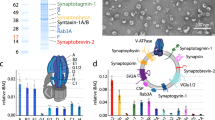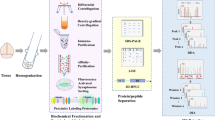Abstract
The LGI1 gene has been shown to predispose to epilepsy and influence cell invasion in glioma cells. To identify proteins that interact with LGI1 and gain a better understanding of its function, we have used co-immunoprecipitation (co-IP) of a secreted green fluorescent protein-tagged LGI1 protein combined with mass spectrometry to identify interacting partners from lysates prepared from human subcortical white matter. Proteins were recovered from polyacrylamide gels and analyzed using liquid chromatography coupled to tandem mass spectrometry. This analysis identified a range of proteins, but in particular synaptotagmin, synaptophysin, and syntaxin 1A. Each of these proteins is found associated with synaptic vesicles. These interactions were confirmed independently by co-IP and Western blotting and implicate LGI1 in synapse biology in neurons. Other vesicle-related proteins that were recovered by co-IP include clathrin heavy chain 1, syntaxin binding protein 1, and a disintegrin and metalloprotease 23. These observations support a role for LGI1 in synapse vesicle function in neurons.



Similar content being viewed by others
References
Alfonso, J., Fernández, M. E., Cooper, B., Flugge, G., & Frasch, A. C. (2005). The stress-regulated protein M6a is a key modulator for neurite outgrowth and filopodium/spine formation. Proceedings of the National Academy of Sciences of the United States of America, 102, 17196–17201. doi:10.1073/pnas.0504262102.
Chapman, E. R. (2008). How does synaptotagmin trigger neurotransmitter release? Annual Review of Biochemistry, 77, 615–641. doi:10.1146/annurev.biochem.77.062005.101135.
Chernova, O. B., Somerville, R. P. T., & Cowell, J. K. (1998). A novel gene, LGI1, from 10q24 is rearranged and downregulated in malignant brain tumors. Oncogene, 17, 2873–2881. doi:10.1038/sj.onc.1202481.
Fernández-Chacón, R., Shin, O. H., Königstorfer, A., et al. (2002). Structure/function analysis of Ca2+ binding to the C2A domain of synaptotagmin 1. The Journal of Neuroscience, 22, 8438–8446.
Fili, O., Michaelevski, I., Bledi, Y., Chikvashvili, D., Singer-Lahat, D., Boshwitz, H., et al. (2001). Direct interaction of a brain voltage-gated K+ channel with syntaxin 1A: functional impact on channel gating. The Journal of Neuroscience, 21, 1964–1974.
Fukata, Y., Adesnik, H., Iwanaga, T., Bredt, D. S., Nicoll, R. A., & Fukata, M. (2006). Epilepsy-related ligand/receptor complex LGI1 and ADAM22 regulate synaptic transmission. Science, 313, 1792–1795. doi:10.1126/science.1129947.
Gutierrez-Delicado, E., & Serratosa, J. M. (2004). Genetics of the epilepsies. Current Opinion in Neurology, 17, 147–153. doi:10.1097/00019052-200404000-00011.
Head, K., Gong, S., Joseph, S., et al. (2007). The expression pattern of the LGI1 gene in tissues and organs from BAC transgenic mice demonstrate a neuronal and glial expression pattern as well as other distinct cell types in the adult animal. Mammalian Genome, 18, 328–337. doi:10.1007/s00335-007-9024-6.
Hirose, S., Mitsudome, A., Okada, M., et al. (2005). Genetics of idiopathic epilepsies. Epilepsia, 46(Suppl 1), 38–43. doi:10.1111/j.0013-9580.2005.461011.x.
Kalachikov, S., Evgrafov, O., Ross, B., et al. (2002). Mutations in LGI1 cause autosomal-dominant partial epilepsy with auditory features. Nature Genetics, 30, 335–341. doi:10.1038/ng832.
Ko, J., & Kim, E. (2007). Leucine-rich repeat proteins of synapses. Journal of Neuroscience Research, 85, 2824–2832. doi:10.1002/jnr.21306.
Kunapuli, P., Chitta, K. S., & Cowell, J. K. (2003). Suppression of the cell proliferation and invasion phenotypes in glioma cells by the LGI1 gene. Oncogene, 22, 3985–3991. doi:10.1038/sj.onc.1206584.
Kunapuli, P., Kasyapa, C., Hawthorn, L., & Cowell, J. K. (2004). LGI1, a putative tumor metastasis suppressor gene, controls in vitro invasiveness and expression of matrix metalloproteinases in glioma cells through the Erk1/2 pathway. The Journal of Biological Chemistry, 279, 23151–23157. doi:10.1074/jbc.M314192200.
Mitchell, K. J., Pinson, K. I., Kelly, O. G., et al. (2001). Functional analysis of secreted and transmembrane proteins critical to mouse development. Nature Genetics, 28, 241–249. doi:10.1038/90074.
Park, W. J., Lee, S. E., Kwon, N. S., Baek, K. J., Kim, D. S., & Yun, H. Y. (2008). Leucine-rich glioma inactivated 3 associates with syntaxin 1. Neuroscience Letters, 444, 240–244. doi:10.1016/j.neulet.2008.08.044.
Qualmann, B., & Kessels, M. M. (2002). Endocytosis and the cytoskeleton. International Review of Cytology, 220, 93–114. doi:10.1016/S0074-7696(02)20004-2.
Sagane, K., Hayakawa, K., Kai, J., et al. (2005). Ataxia and peripheral nerve hypomyelination in ADAM22-deficient mice. BMC Neurosciences, 6, 33.
Sagane, K., Ishihama, Y., & Sugimoto, H. (2008). LGI1 and LGI4 bind to ADAM22, ADAM23 and ADAM11. International Journal of Biological Sciences, 4, 387–396.
Saitsu, H., Kato, M., Mizuguchi, T., et al. (2008). De novo mutations in the gene encoding STXBP1 (MUNC18-1) cause early infantile epileptic encephalopathy. Nature Genetics, 40, 782–788. doi:10.1038/ng.150.
Schulte, U., Thumfart, J. O., Klöcker, N., et al. (2006). The epilepsy-linked Lgi1 protein assembles into presynaptic Kv1 channels and inhibits inactivation by Kvbeta1. Neuron, 49, 697–706. doi:10.1016/j.neuron.2006.01.033.
Takahashi, N., Hatakeyama, H., Okado, H., Miwa, A., Kishimoto, T., Kojima, T., et al. (2004). Sequential exocytosis of insulin granules is associated with redistribution of SNAP25. The Journal of Cell Biology, 165, 255–262. doi:10.1083/jcb.200312033.
Tomas, A., Meda, P., Regazzi, R., Pessin, J. E., & Halban, P. A. (2008). Munc 18-1 and granuphilin collaborate during insulin granule exocytosis. Traffic (Copenhagen, Denmark), 9, 813–832. doi:10.1111/j.1600-0854.2008.00709.x.
Acknowledgments
We are grateful to Rama-Dey Rao and Kyoung-Soo Choi for assistance with the proteomics analysis. This work was supported by grant CA from the National Institutes of Health. The authors have no conflicts of interest.
Author information
Authors and Affiliations
Corresponding author
Electronic supplementary material
Supplemental Figures S1–3
Chromatograms, MS and MS/MS Spectra of representative peptides from: (Figure S1) synaptotagmin, m/z 792.91, [M+2H]+2, TLNPVFNEQFTFK; (Figure S2) synaptophysin, m/z 502.88, [M+3H]+3, LHQVYFDAPTCR; (Figure S3) Adam23, m/z 618.84, [M+2H]+2, SVVNLVDSIYK. The procedures for processing the immunoprecipitated sample by 1D SDS-PAGE, in-gel trypsinization of the protein bands, LC–MS/MS, and database search for peptide and protein identification are described in the text. The base peak intensities (BPI) and extracted ion current (EIC) chromatograms are shown in (A) and (B), respectively, and the inserts in (B) show the MS spectra of the peptides. The MS/MS spectra and de novo sequencing indicating the b and y ions that were identified are shown in (C). The MASCOT scores and peptide mass tolerances (shown in parentheses) are also reported. (PDF 713 kb)
Rights and permissions
About this article
Cite this article
Kunapuli, P., Jang, GF., Kazim, L. et al. Mass Spectrometry Identifies LGI1-Interacting Proteins that Are Involved in Synaptic Vesicle Function in the Human Brain. J Mol Neurosci 39, 137–143 (2009). https://doi.org/10.1007/s12031-009-9202-y
Received:
Accepted:
Published:
Issue Date:
DOI: https://doi.org/10.1007/s12031-009-9202-y




